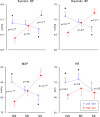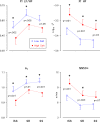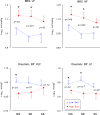Hemodynamic and Autonomic Response to Different Salt Intakes in Normotensive Individuals
- PMID: 27503851
- PMCID: PMC5015293
- DOI: 10.1161/JAHA.116.003736
Hemodynamic and Autonomic Response to Different Salt Intakes in Normotensive Individuals
Abstract
Background: Even if sodium sensitivity represents a risk factor at any blood pressure (BP) level, limited evidence is available that it may influence cardiovascular control in normotensives, particularly in white individuals. Therefore, the aim of the study was to investigate whether sodium sensitivity alters hemodynamic or autonomic responses to salt in normotensives.
Methods and results: We evaluated the Sodium-Sensitivity Index (SS-Index) in 71 white normotensives after 5 days of high- and low-sodium diets. We measured BP continuously at the end of each period, estimating hemodynamic indices from BP waveform analysis, and autonomic indices from heart rate (HR) and BP variability. According to the SS-Index distribution, we defined 1 sodium-sensitive group (SS, with SS-Index >15 mm Hg/[mmol·day]), 1 sodium-resistant group, (unresponsive to sodium load with -15≤ SS-Index ≤+15), and 1 inverse sodium-sensitive group, responsive to sodium by decreasing BP, with SS-Index <-15). We compared the effects of the diets among groups, and correlated autonomic/hemodynamic indices with the SS-Index. After sodium loading, a significant decrease in systemic peripheral resistances, HR, spectral indices of BP modulation, and a significant increase of indices of HR vagal modulation were found in the inverse sodium-sensitive group but not in SS normotensives. Moreover, the highest SS-Indices were associated with the lesser vagal HR decelerations.
Conclusions: Our data suggest that salt sensitivity in white normotensive individuals is associated with impaired vasodilation and altered autonomic response to dietary salt. Such dysfunction may critically contribute to induce a BP response to dietary salt.
Keywords: autonomic function; baroreflex; blood pressure spectral analysis; heart rate variability; peripheral resistance; salt intake; salt‐sensitive.
© 2016 The Authors. Published on behalf of the American Heart Association, Inc., by Wiley Blackwell.
Figures





References
-
- Morimoto A, Uzu T, Fujii T, Nishimura M, Kuroda S, Nakamura S, Inenaga T, Kimura G. Sodium sensitivity and cardiovascular events in patients with essential hypertension. Lancet. 1997;350:1734–1737. - PubMed
-
- Weinberger MH, Fineberg NS, Fineberg SE, Weinberger M. Salt sensitivity, pulse pressure, and death in normal and hypertensive humans. Hypertension. 2001;37:429–432. - PubMed
-
- Campese VM, Romoff MS, Levitan D, Saglikes Y, Friedler RM, Massry SG. Abnormal relationship between sodium intake and sympathetic nervous system activity in salt‐sensitive patients with essential hypertension. Kidney Int. 1982;21:371–378. - PubMed
-
- Coruzzi P, Parati G, Brambilla L, Brambilla V, Gualerzi M, Novarini A, Castiglioni P, Di Rienzo M. Effects of salt sensitivity on neural cardiovascular regulation in essential hypertension. Hypertension. 2005;46:1321–1326. - PubMed
-
- Minami J, Kawano Y, Ishimitsu T, Takishita S. Blunted parasympathetic modulation in salt‐sensitive patients with essential hypertension: evaluation by power‐spectral analysis of heart‐rate variability. J Hypertens. 1997;15:727–735. - PubMed
Publication types
MeSH terms
Substances
LinkOut - more resources
Full Text Sources
Other Literature Sources
Medical

